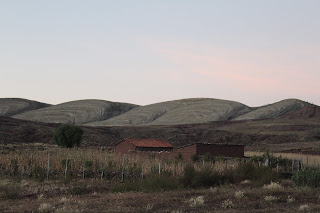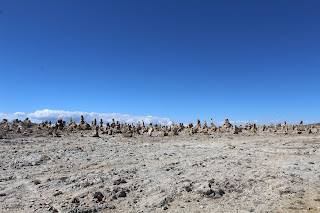Following the Inca trails
The Incan empire had outposts from Ecuador to Chile, with the central areas around lake Titicaca. All these areas were linked by trails that the imperial messengers and armies could use to get around, and in many parts of the modern countries (esp Peru and Bolivia) long stretches of mountain-hopping paths still remain.
We've been lucky enough to trek through three inca trails in the Andes of Bolivia and Peru, starting in the beautiful city of Sucre, southern Bolivia.
The first trail we trekked was near Sucre in Bolivia, starting altitude around 3600m (not sure how high we ended up). It took us through some high altitude dry forests to a crater where we stayed in a local village. No one is sure if the crater was once a meteorite, an underwater volcano, or the result of conflicting seismic forces, but in many ways it is like a reclusive celebrity: a decent size, shapely, and quite picturesque from many different angles, though access can be a bit challenging.
Lake Titcaca islands
Lake Titicaca is the home turf of the Incas. Their creation legend has the first Inca and his family emerging miraculously from the lake and marching north to find a good place to found an empire around (the future Cusco). There are still two dominant indigenous groups - the Quechua/Inca (north) and the Aymara (south) that live around the lake, only speak Spanish as a second language and make up the majority of the population of Peru and Bolivia.
Lake Titicaca is deep, clear and cold in the south around Isla Del Sol (3800-4000m) which was once the scene of important annual religious pilgrimages. We hiked across the island on the remaining trail, partly to check out the ruins there, but also partly to find somewhere to watch the Copa America, which was in its early stages and not easy to find on an island without reliable radio signal or electricity.
Around Uros islands in the south the lake is shallow, reedy and full of algae. The Uros people, a bit like the Venetians, fled to man-made islands to escape from the dominant Inca and Aymara people. These were made entirely from the native reeds, which are not hollow but filled with a spongy cellular structure that makes them float. Each island is a sandwich of continually-renewed layers of reeds which last for about forty years with regular maintenance.
Urubamba Valley
Inca central: every hill has a trail, every other hill has an old city. Unlike nearly everyone else, the Incas liked to build on mountain tops, even when more hospitable valleys were available to them. It's wasn't only for defense, as most towns (like Machu Picchu) are not very fortified. Also, was not for protection from natural disasters; while they avoided floods, they were more vulnerable to landslides. Just a preference.
We did not do the traditional Inka trail, which visits five ancient towns, including Machu Picchu; we took a different trail through the Vilcabamba region, the last holdout of the Incan empire and more recently the heart of Peruvian cocaine production.
Along the way we included some cycling, whitewater rafting (new favourite thing) and zip lining, to break up the long steep marches. Machu Picchu itself was better then we expected; easy to look at, with lots of interesting angles on offer. It's a hard climb but when you get there, it's a miraculous place.
The Incan empire lost to the Spanish in very mysterious ways. After Pizarro tricked the Inca, took him hostage then killed him, he, his brothers and his lieutenant Amarga successively tricked, bribed and murdered successive members of the surviving Incan royal family (and each other) until they revolted. For a long time there were only 300 Spanish soldiers to maintain control, yet they managed time and time again to fend off Incan armies, much to their own surprise. If anyone was betting on the successful colonisation, the Spanish occupation is a great example of a long shot that unexpectedly paid off.
For a long time the last resistance was based in the area adjacent to Machu Picchu, and the need of the rebellion to conscript soldiers is very likely the reason it was eventually abandoned.
A few hundred years later, some latter-day Inca heroes emerged to help throw off the yoke of Spanish colonialism, caught up in the revolutions of San Martin and Bolivar in the early 19th century. One such was Juana Azurduy de Padilla, who recruited a large force of irregulars and even led them in battles herself. Bolivar appointed her as a colonel when he arrived on the scene, but she was subsequently excluded by Sucre from the Declaration of Independence due to her race and gender. She was posthumously appointed a general of both the Argentinian and Bolivian armies.
In broad terms, the Incan empire (Tawantisuyu) was divided into four quarters that roughly matched either georaphical regions or conquered smaller states: north was Chichansuyu, which correspoinded with teh conquered smaller states making up modern Ecuador, parts of Colombia and north Peru. South was Collasuyu, the altiplano region of Titicaca, Aymara, modern Bolivia, north Argentina and north Chile. After the death of the Inca immediately prior to the Spanish invasion, Chichansuyu defeated Collasuyu in a civil war that (together with a smallpox and influenza epidemic) left the Inca state vulnerable to the Spanish. The coastal region immediately west of Cusco was Cuntinsuyu, and the jungle frontier zone east of Cusco was Antisuyu.
The central point of the lines dividing the empire was the great template Qorikancha in Cusco. This template was stripped of its gold to ransom the Inca back from Pizarro, and now has a Dominican convent built on top of it, but is still used as the ceremonial starting point of the revived (since 1944) Incan festival of the winter equinox Inti Raymi.
Inti Raymi
The central point of the lines dividing the empire was the great template Qorikancha in Cusco. This template was stripped of its gold to ransom the Inca back from Pizarro, and now has a Dominican convent built on top of it, but is still used as the ceremonial starting point of the revived (since 1944) Incan festival of the winter equinox Inti Raymi.
Inti Raymi
Our adventures
through the Andes finished at Inti Raymi festival in Cusco. Inti
Raymi ("Festival of the Sun") was a religious ceremony of the Inca
Empire in honor of the god Inti, one of the most venerated deities in Inca
religion. It was the celebration of the Winter Solstice - the shortest day of
the year in terms of the time between sunrise and sunset and the Inca New Year.
During the Inca Empire, the Inti Raymi was the most important of four
ceremonies celebrated in Cusco. The festival attracts tens of thousands locals
and extranjeros and goes for days throughout the streets of Cusco before the
final Inti Raymi is held in Saqsaywamen. The festival is still performed with
many of the traditional rituals including the sacrifice of a llama, where the
priests tear out its heart, lungs and trachea. Right in front of us all.
Neo-Incan/colonial city living: Sucre and Cusco
Apart from
trekking along the inca trails, sucre and cusco are top cities with
lots to do and see. Below are some of our highlights.
Sucre fruit juice markets
Cusco markets
Farming
The Incas practised a wide variety of farming practices, which included potatoes and livestock in the highlands, corn and quinoa in the lower areas, and fruit in the cloud forest and jungle areas. They built steps into almost every single hill around lake Titicaca, and many others further out in the empire, where they built irrigated raised garden beds that also prevented landslides.
































3 Comments:
Good post! I think Inti Raymi (from memory) featured in a Tintin book. I'll have to check when I get home. - Rahul.
Yes! Prisoners of the Sun was the Tintin book!
Sam and Maayan this was fantastic to read. Such a feast of beauty, fun and fascinating facts.
Stay well. Incredible to think how people adapt to live at such high altitudes.
What a Wonderfull experience!!! Congratulations, you made it to Machu Picchu!!! Amazing pictures.
Que buena experiencia! los felicito, llegaron por fin a Machu Picchu!! Y buenísimas las fotos! Besos y abrazos.
Post a Comment
<< Home